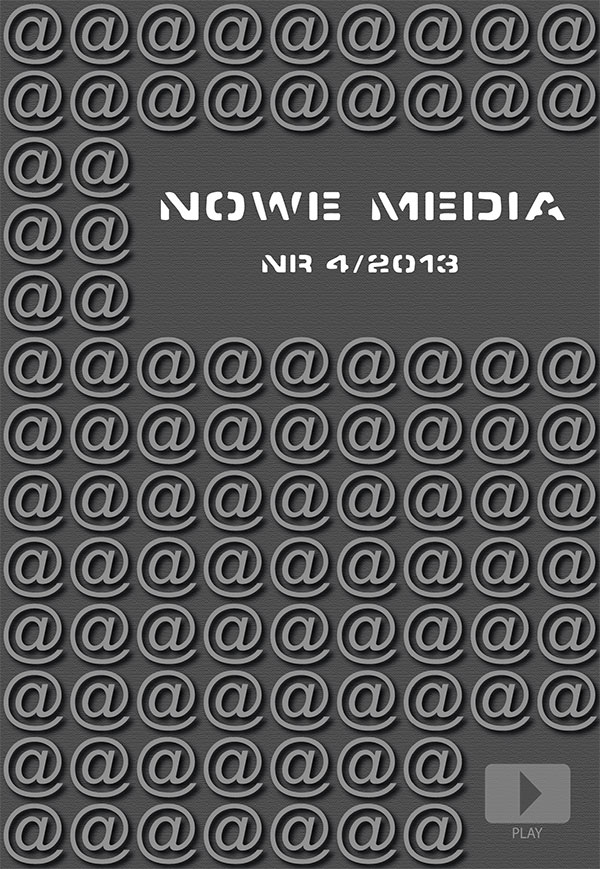Aplikacje mobilne: innowacyjność, sytuacyjność i personalizacja komunikacji marketingowej i wizerunkowej
DOI:
https://doi.org/10.12775/NM.2013.001Słowa kluczowe
media mobilne, komunikacja mobilna, aplikacje mobilne, marketing i public relationsAbstrakt
Aplikacje mobilne stanowią nowe narzędzie komunikacji marketingowej i wizerunkowej. Autorka proponuje ich charakterystykę akcentującą trzy zasadnicze cechy: innowacyjność, sytuacyjność i personalizację komunikacji. Cechy te zostały omówione w oparciu na analizie aplikacji mobilnych, mających zastosowanie komercyjne. Należą do nich aplikacje AR (Augmented Reality), a więc rozszerzonej rzeczywistości, aplikacje oparte na lokalizacji (location-based), społecznościowe aplikacje agregacyjne. Celem artykułu jest próba uchwycenia wybranych cech komunikacji mobilnej za pomocą aplikacji oraz określenie jej możliwości i ograniczeń w zakresie marketingu i public relations. Analizę poprzedza charakterystyka badań nad komunikacją mobilną w kontekście komunikacji marketingowej i wizerunkowej.
Bibliografia
Gumpert Gary, Drucker Susan. 2007. Mobile Communication in the Twenty-first Century or “Everybody, Everywhere at Any Time, [w:[ S. Kleinman (red.), Displacing Place. Mobile Communication in the Twenty-first Century. New York: Peter Lang.
Kopecka-Piech Katarzyna. 2013. Afordancje mediów mobilnych, [w:] M. Sokołowski (red.), Nowe media i wyzwania współczesności. Toruń: Wydawnictwo Adam Marszałek, ss. 40–52.
Lange Michael de. 2009. From Always-on to Always-there: Locative Media and Playful Identities, [w:] A. de Souza e Silva, D. Sutko (red.), Digital Cityscapes. Merging Digital and Urban Playspaces. Berlin: Peter Lang.
Okada Tamoyuki. 2005. Youth Culture and the Shaping of Japanese Mobile Media: Personalization and the Keitai Internet and Multimedia, [w:] M. Ito, D. Okabe, M. Matsuda (red.), Personal, Portable, Pedestrian: Mobile Phones in Japanese Life. Cambridge: MIT Press.
Souza e Silva Adriana de. 2009. Digital Cityscapes: Merging Digital and Urban Playscapes, New York: Peter Lang.
Szmigin Isabelle. 2003. Understand the Consumer. Innovation and the Creative Consumer. London: Sage Publications Ltd.
Tähtinen Jaana. 2006. Mobile Advertising or Mobile Marketing. A Need for a New Concept, [w:] FeBR 2005 – Frontiers of e-Business Research 2005, Conference Proceedings of eBRF 2005.
Verhoeff Nanna. 2012. Mobile Screens. The Visual Regime of Navigation, Amsterdam: Amsterdam University Press.
Wang Wen-Chia, Young Mark, Love Steve, Coxon Ian. 2010. Understanding Touch Screen Mobile Phone Users by Taxonomy of Experience (TOE), [w:] Poppinga Benjamin i in. (red.), Observing Mobile User Experience. Proceeding of the First International Workshop Held in Conjunction with NordCHI, http://su.diva-portal.org/smash/get/diva2:386449/FULLTEXT01#page=15, 1.02.2013.
Artykuły w pismach naukowych/specjalistycznych
Chojnacki Wojciech. Kontent is king. „Raport: Marketing Mobilny w Polsce 2012–2013”, s. 99, http://jestem.mobi/wpcontent/uploads/2013/01/Raport_marketing_mobilny_w_Polsce_2012_2013_jestemmobi.pdf, 1.02.2013.
Dwornik Bartłomiej. 2012. Marketing Mobilny. Rewolucja stała się faktem, „Raport: Marketing Mobilny”, s. 6-18, http://interaktywnie.com/biznes/artykuly/mobile/raport-interaktywnie-com-marketing-mobilny-23524, 1.02.2013.
Galica Mateusz. 2012. Smartfonizacja Polaków 2012. „Raport: Marketing Mobilny w Polsce 2012–2013”, s. 25. 37, http://jestem.mobi/wpcontent/uploads/2013/01/Raport_marketing_mobilny_w_Polsce_2012_2013_jestemmobi.pdf, 1.02.2013.
Gazzard Alison. 2011. Location, Location, Location: Collecting Space and Place in Mobile Media, „Convergence: The International Journal of Research into New Media Technologies” 17, s. 405-417, doi: 10.1177/1354856511414344, 1.02.2013.
Hjorth Larisa, Kim Kyoung-hwa Yonnie . 2001. Good Grief: the Role of Social Mobile Media in the 3.11 Earthquake Disaster in Japan. „Digital Creativity” 3, s. 552–559, www.tandfonline.com/doi/abs/10.1080/14626268.2011.604 640, 30.12.2011.
Hosokawa Shuhei. 1984. The Walkman Effect. „Popular Music” 4, s. 165-180, http://dx.doi.org/10.1017/s0261143000006218, 1.02.2013.
Kopecka-Piech Katarzyna. 2012. Mobilne media miejskie. „Studia Medioznawcze” 3, s. 111–126.
Kopecka-Piech Katarzyna. 2013. Typologie innowacji medialnych. „Zarządzanie w Kulturze” 4 (14) (w druku).
Kopecka-Piech Katarzyna. 2014. Hybrydyzacja rzeczywistości w mediach mobilnych. „Studia kaliskie” t. 2 (w druku).
Kurkovsky Stan, Harihar Karthik. 2006. Using Ubiquitous Computing in Interactive Mobile Marketing. „Pers Ubiquit Comput” 10, s. 227–240, doi: 10.1007/s00779-005-0044-5, 1.02.2013.
Lemos André. 2008. Mobile Communication and New Sense of Places: a Critique of Spatialization in Cyberculture. „Revista Galáxia” 16, s. 91–108, http://revistas.pucsp.br/index.php/galaxia/article/view/1914/1177, 1.02.2013.
Lemos André. 2010. Post-Mass Media Functions, Locative Media, and Informational Territories: New Ways of Thinking About Territory, Place and Mobility in Contemporary Society. „Space and Culture” 4, s. 403–420, doi: 10.1177/1206331210374144, 1.02.2013.
Nilsson Andreas, Nuldén Urban, Olsson Daniel. 2001. Mobile Media: the Convergence of Media and Mobile Communications. „Convergence: The International Journal of Research into New Media Technologies” 1, s. 34–38, doi: 10.1177/135485650100700105, 1.02.2013.
Ratuszniak Beata. 2012. Wstęp. „Raport: Marketing Mobilny”, s. 2, http://interaktywnie.com/biznes/artykuly/mobile/raport-interaktywnie-com-marketing-mobilny-23524, 1.02.2013.
Rynkiewicz Maciej. 2012. Najlepsi w mobile marketingu. Przeczytaj zestawienie. „Raport: Marketing Mobilny”, s. 44-45, http://interaktywnie.com/biznes/artykuly/mobile/raport-interaktywnie-com-marketing-mobilny-23524, 1.02.2013.
Sadowski Artur. 2012. 20. Urodziny SMS-a. „Raport: Marketing Mobilny w Polsce 2012-2013”, s. 12, http://jestem.mobi/wp-content/uploads/2013/01/Raport_marketing_mobilny_w_Polsce_2012_2013_jestemmobi.pdf, 1.02.2013.
Shankar Venkatesh, Balasubramanian Sridhar. 2009. Mobile Marketing: A Synthesis and Prognosis. „Journal of Interactive Marketing Volume” 23, s. 118–129, http://dx.doi.org/10.1016/j.intmar.2009.02.002, 1.02.2013.
Souza e Silva Adiana de. 2006. From Cyber to Hybrid: Mobile Technologies as Interfaces of Hybrid Spaces. „Space and Culture” 9, s. 261–278, doi: 10.1177/1206331206289022, 1.02.2013.
Souza e Silva Adiana de, Frith Jordan. 2010. Locative Mobile Social Networks: Mapping Communication and Location in Urban Spaces. „Mobilities” 4, s. 485–505, http://www.tandfonline.com/doi/abs/10.1080/17450101.2010.510332, 1.02.2013.
Tronina Adriana. 2012. Aplikacje mobilne jako narzędzia marketingu. „Raport: Marketing Mobilny”, s. 25-30, http://interaktywnie.com/biznes/artykuly/mobile/raport-interaktywnie-com-marketing-mobilny-23524, 1.02.2013.
Varnal Kaan, Toker Ays¸ egül. 2010. Mobile Marketing Research: The-state-of-the-art. „International Journal of Information Management” 30, s. 144–151, doi: 10.1016/j.ijinfomgt.2009.08.009, 1.02.2013.
Wawryszuk Bartosz. 2012. Strona to mus, aplikacja nie dla każdego. „Raport: Marketing Mobilny”, 33–40, http://interaktywnie.com/biznes/artykuly/mobile/raport-interaktywnie-com-marketing-mobilny-23524, 1.02.2013.
Artykuły w prasie codziennej
Kosner Anthony Wing. 2012. The Appification of Everything Will Transform The World’s 360 Million Web Sites. „Forbes”, 16.12., http://www.forbes.com/sites/anthonykosner/2012/12/16/forecast-2013-the-appification-of-everythingwill-turn-the-web-into-an-app-o-verse/, 1.02.2013.
Źródła internetowe
Crook Jordan. 2012. Apple App Store Hits 650,000 Apps: 250,000 Designed For iPad,
$5.5B Paid Out To Devs, http://techcrunch.com/2012/07/24/apple-app-store-hits-650000-apps-250000-designed-for-ipad-5-5b-paid-out-to-devs/, 1.02.2013
Pobrania
Opublikowane
Jak cytować
Numer
Dział
Statystyki
Liczba wyświetleń i pobrań: 3228
Liczba cytowań: 0



